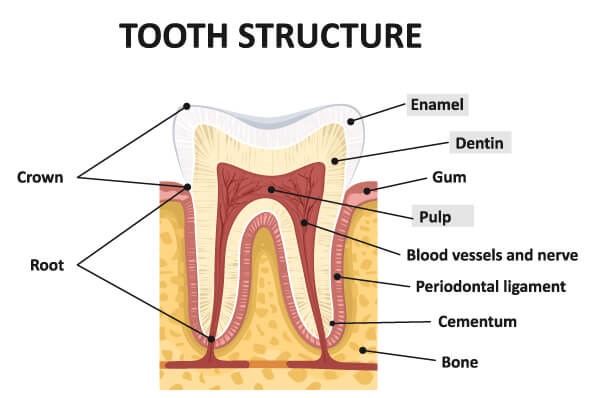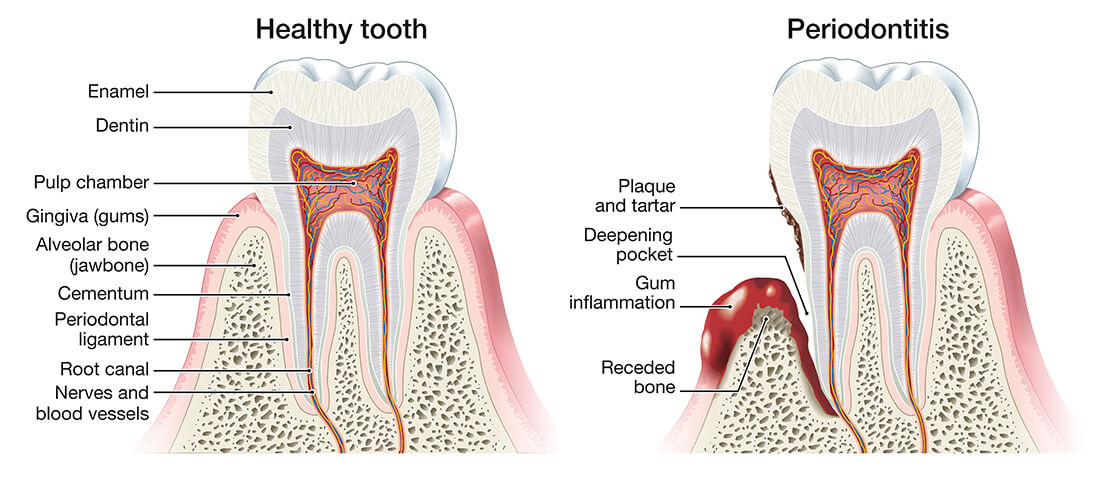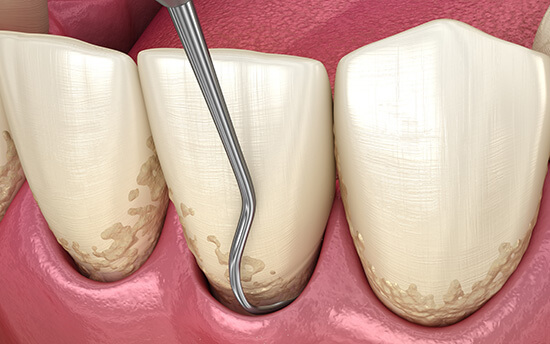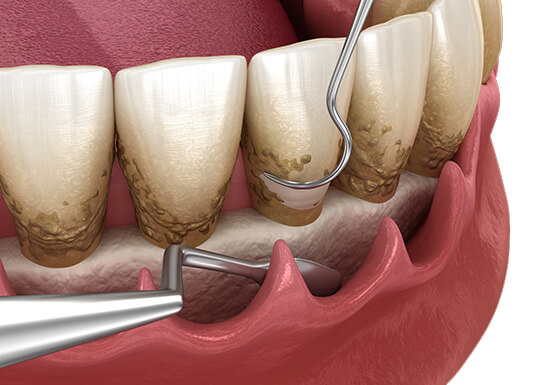Periodontitis
The tissues around your teeth are called the periodontium and comprise the cementum, periodontal ligament, and alveolar bone. Cementum is a thin layer of mineralized tissue that covers the roots of your teeth; periodontal ligament is a soft tissue that acts as a shock absorber between your tooth and jaw bone; and alveolar bone is a special type of jaw bone that supports your teeth.
These tissues play an essential role in the day-to-day function of your teeth and mouth, by resisting and dissipating forces created during normal oral function, such as chewing and grinding, from causing pain and discomfort.
Two of the most common diseases that affect these tissues are gingivitis and periodontitis.

Periodontitis is an inflammatory condition which causes irreversible destruction of the supporting structures around your teeth. Left untreated, the damage can be so severe that your teeth end up falling out or need to be removed by a dentist. Around 25% of the population has moderate to severe forms of the disease, whilst around half of all people will experience some periodontal destruction in their lifetime.
Periodontitis is always preceded by gingivitis , although only about half of people with gingivitis develop periodontitis. Whilst gingivitis involves inflammation of your gums, periodontitis is a much more complex interaction between your immune system and the bacteria in your mouth. Put simply, the bacteria stimulates your body’s immune system to attack the supporting structures around your teeth.
This results in the formation of gingival pockets around your teeth, as the bone shrinks away faster than your gums. Left unchecked, the gingival pockets and bone loss can be so severe that your teeth become painful and need to be removed.

In addition to the signs and symptoms of gingivitis there are a number of indicators that might indicate you have periodontitis, including:
Teeth that look long
Showing the join between the white enamel on your crown and the yellow dentine of your root
Tooth sensitivity
Food getting caught between your teeth
Bad smells from your gums and mouth
Loose teeth
You’ve noticed big changes to your bite
Gingivitis is a prerequisite for periodontitis. That is, the release of bacterial toxins from the dental biofilm (plaque) is required to stimulate your immune system to produce an inflammatory response. However, a number of factors can interfere with this response and result in destruction of the toot supporting structures, including:
Smoking
Diabetes
Obesity
Cardiovascular Disease
Genetic Predisposition
Treatment
This includes removal of the dental calculus and biofilm from your tooth roots, in a process known as tooth debridement.
This includes the use of specialised hand and electrical instruments to remove the bacteria, calculus and biofilm off the root surfaces, resulting in a clean tooth to allow your gums to heal tight.
This treatment aims to reduce the bacterial load around your teeth.

Your dental professional will discuss your medical health with you, and possibly your medical practitioners, to ensure any medical conditions are controlled as best as possible. This will help your immune system be in the best possible condition to respond to any oral bacteria. This includes assessments for diabetes, smoking cessation or reduction, and general dental care.
To prevent biofilm build-up and maintain your oral health, it is important to clean your teeth and gums twice daily. Electric toothbrushes are recommended over manual toothbrushes because it improves access to those hard-to-reach teeth and surfaces in the back of your mouth.
Dental floss or interdental brushes should be used to clean in between your teeth, where your toothbrush bristles can’t reach. We recommend fluoridated or sensitive type toothpastes to help harden and protect your teeth. Short-term (a couple of weeks) use of mouthwashes might be recommended to reduce your gingivitis.
Occasionally we might also recommend other adjunctive products for your oral health.

Regularly having your oral health checked is important to maintain a healthy mouth. Your dental professional will recommend a maintenance and review program tailored to your needs.
The treatment for periodontitis may also include some advanced surgical procedures. These include:
Access surgery: some teeth and areas of your mouth are extremely difficult to reach. Occasionally, we may need to lift the gums away from your teeth to make it easier to remove the bacteria. During this process there may be some removal of disease gum and bone from around your teeth, to make healing and oral hygiene easier after the procedure.
Regenerative surgery: In some cases, we may attempt to try and regrow the periodontium around a tooth or teeth. The aim is to provide more support for the teeth, better resistance to ongoing dental disease and improve access for oral hygiene.

